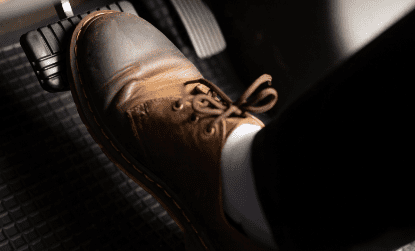Every second and every foot counts when it comes to braking. No vehicle comes to a complete halt the second the driver applies the brakes. Depending on your speed, your vehicle will continue moving after you have applied the brakes.
What does braking distance mean?
Braking distance is the distance your vehicle will travel from when you fully apply its brakes to when it comes to a complete stop. It is one of the two principal components of any vehicle’s total stopping distance, which is the distance your vehicle travels from the time you see a hazard and apply the brakes until the vehicle comes to a full stop.
The second component is reaction distance, which is the product of the speed at which a vehicle is moving and the perception-reaction time of the driver. Reaction distance is the distance you travel from the point when you detect a hazard until you start braking. The standard perception-reaction time is 1.5 seconds. With ideal road and weather conditions, however, many drivers can stop sooner, thanks to a shorter perception-reaction time.
What are the factors that affect braking distance?
Braking distance is affected by multiple factors. Here are the 7 most common:
1. Your original speed and the coefficient of friction between your tires and the road surface
The coefficient of friction (COF) is often symbolized by the Greek letter µ. The standard COF is 0.7, a figure that is largely used in accident reconstruction and judicial notice. The higher your speed, the greater your braking distance. That is, the faster you’re going, the longer it takes for you to come to a complete stop after you’ve applied the brakes.
2. Your tires’ rolling resistance
Rolling resistance (also called rolling friction or rolling drag) is the combination of forces that resist the forward motion of a vehicle as its tires roll on the road’s surface. If your tires have a low rolling resistance, they allow you to have better control of your car and to stop sooner.
3. Your vehicle’s air drag
Aerodynamic drag is a resistance force that the oncoming air applies on your moving vehicle. Having the least possible amount of air drag helps improve other performance characteristics of your vehicle, including handling and acceleration.
4. Your skills as a driver
It’s not just about how well you handle applying the brakes itself; it’s also about your level of concentration and situational awareness.
5. Road condition
Rain, snow, ice, wet leaves, gravel, mud, etc., can greatly reduce road traction. With less traction, your vehicle is likely to take a bit longer to come to a complete stop after you’ve applied the brakes.
6. Vehicle condition
If your vehicle has perfectly working tires (especially if they are low-rolling-resistance tires), regularly replaced shock absorbers, and an excellent-condition braking system (especially if your vehicle has an anti-lock braking system, or ABS), you should be able to fully stop within a short distance.
7. Load
If your vehicle is loaded up with equipment, supplies, passengers, etc., the added weight can increase your braking distance.
Being situationally aware when you’re behind the wheel helps you avoid accidents and unnecessary expenses in the form of costly repairs. Being mindful when it comes to braking is one way to drive safely and help everyone else stay safe on the road, not to mention keep your budget protected.
For more great savings opportunities, especially when it comes to necessary repairs, some of our products may just suit your needs. Check them out today, especially if your manufacturer’s warranty is running out soon.

